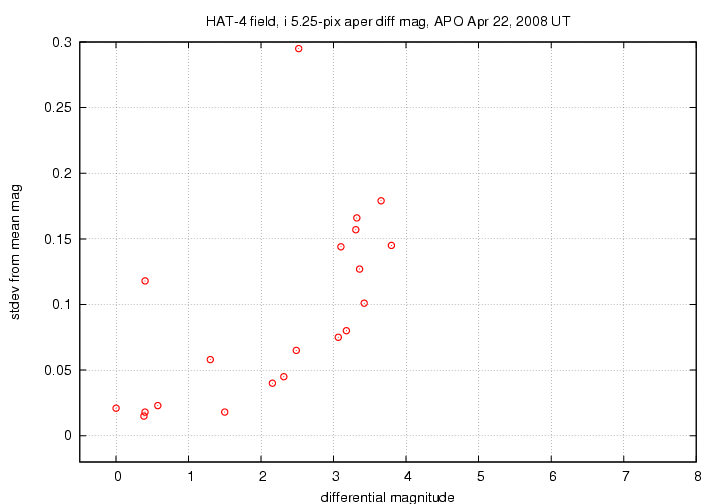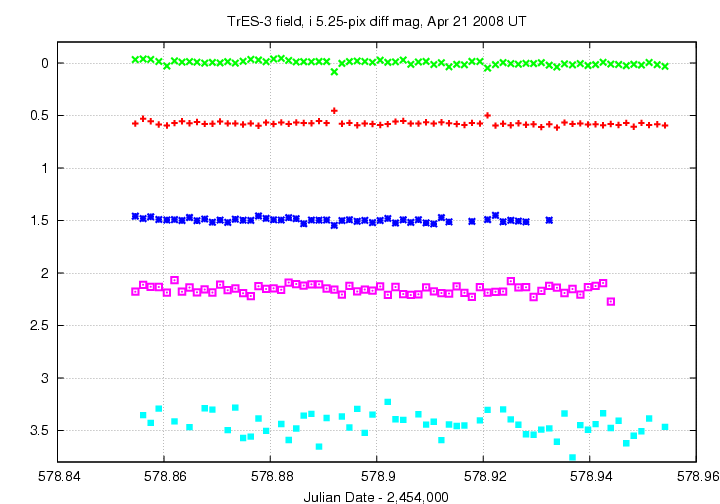
On the night of UT Feb 24, 2008, the SDSS Photometric Telescope ("PT" for short) took a series of exposures of HAT-4. The data is very noisy, for reasons I don't understand, and so we don't detect the transit.
Notes from the night
This is a chart of the field. HAT-4 is the bright star indicated by the crosshairs. The labelled stars will appear in later analysis. The star marked by two line segments turns out to be just too bright to use as a comparison with the 40-second exposure time.

As a side note, there are several eclipsing binary stars in this field. I had to mark them as "variable" before running the photometric solution below.
The host star of HAT-4 has a magnitude V=11.20 according to HAT-P-4b: A Metal-rich Low-Density Transiting Hot Jupiter .
Following the procedures outlined by Kent Honeycutt's article on inhomogeneous ensemble photometry, I used all stars available in each image to define a reference frame, and measured each star against this frame. You can find the software package used to do the ensemble photometry online; it's free!
The night was apparently fair. The graph below shows the amount by which instrumental magnitudes from each image needed to be shifted to match the ensemble reference. On a clear night, this graph would show a straight horizontal line.

Below is a graph of the scatter in differential magnitude versus magnitude in the ensemble solution.

HAT-4 is the star near differential mag 0.0; it shows NO excess of scatter over neighboring stars of the same brightness. The "noise floor" in these measurements is about 0.015 mag -- very poor, for reasons I don't understand.
Below are the light curves for the target (green symbols) and some comparison stars in the field.

In this closeup, I have shifted the data for two comparison stars to move them closer in magnitude to the target.

The ingress is too noisy to see -- it would be at about 520.810 (see ephemeris below). I estimate by eye the egress to occur at about 520.98.
An ephemeris grabbed from transitsearch.org predicts for this night
----------------------------------------------------------------------------------------
Begin Transit Window PREDICTED CENTRAL TRANSIT End Transit Window
All Times UT
HJD Year M D H M
2454578.88 2008 4 22 9 11 2454578.98 2008 4 22 11 28 2454579.07 2008 4 22 13 44
----------------------------------------------------------------------------------------
The ephemeris ingress of UT 2008 Apr 22 09:11:00 corresponds to JD 2,454,578.883 -- that's before our measurements began. The ephemeris egress of UT 2008 Apr 22 13:44:00 corresponds to JD 2,454,579.072, long after the measurements ended. In other words, we missed both ingress and egress (according to the transitsearch.org ephemeris).
You can grab the measurements for your own analysis. Below is a table with three flavors of time, plus the differential magnitude of the target and an estimate of the uncertainty in each measurement. I show the first few lines of the file to give you an idea of its format.
# Measurements of HAT-4 made with APO PT, Apr 22, 2008 UT. # Each exposure 40 seconds long in SDSS i-band; # Tabulated times are midexposure (FITS header time - half exposure length) # and accurate only to +/- 1 second (??). # 'mag' is a differential magnitude based on ensemble photometry # using a circular aperture of radius 5.25 arcseconds. # # UT day JD-2,450,000 HJD-2,450,000 mag uncert Apr22.85464 4578.85464 4578.85821 -0.032 0.018 Apr22.85610 4578.85610 4578.85967 -0.038 0.025 Apr22.85752 4578.85752 4578.86109 -0.034 0.020
Last modified 05/28/2008 by MWR.